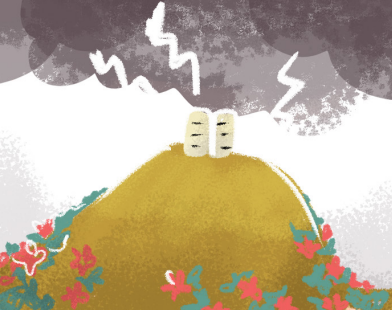
Midrash מִדְרָשׁ
וּלְקַחְתֶּם לָכֶם בַּיּוֹם הָרִאשׁוֹן פְּרִי עֵץ הָדָר כַּפֹּת תְּמָרִים וַעֲנַף עֵץ עָבֹת וְעַרְבֵי נָחַל
וּשְׂמַחְתֶּם לִפְנֵי יהוה אֱלֹהֵיכֶם שִׁבְעַת יָמִים׃
Take for yourselves on the first day fruit of the beautiful tree, date palm branches, leaves of thick trees, and brook willows—and rejoice before God your Lord seven days.
- “fruit of the beautiful tree” אֶתְרוֹג (etrog, citron)
- “date palm branches” לוּלָב (lulav, palm frond)
- “leaves of thick trees” הָדָּסים (hadassim, myrtle leaves)
- “brook willows” עֲרָבוֹת (aravot, willow leaves)

What do the arba minim represent?
פְּרִי עֵץ הָדָר, זֶה הַקָּדוֹשׁ בָּרוּךְ הוּא שֶׁכָּתוּב בּוֹ :הוֹד וְהָדָר לָבָשְׁתָּ (תהלים קד:א).
כַּפֹּת תְּמָרִים, זֶה הַקָּדוֹשׁ בָּרוּךְ הוּא שֶׁכָּתוּב בּוֹ: צַדִּיק כַּתָּמָר יִפְרָח (תהלים צב:יג).
וַעֲנַף עֵץ עָבֹת, זֶה הַקָּדוֹשׁ בָּרוּךְ הוּא, דִּכְתִיב: וְהוּא עֹמֵד בֵּין הַהֲדַסִּים (זכריה א:ח).
וְעַרְבֵי נָחַל, זֶה הַקָּדוֹשׁ בָּרוּךְ הוּא, דִּכְתִיב בֵּיהּ: סֹלּוּ לָרֹכֵב בָּעֲרָבוֹת בְּיָ-הּ שְׁמוֹ (תהלים סח:ה).
“Fruit of the beautiful (hadar) tree”—this is God, about Whom it is written, “You wear glory and beauty (hadar)” (Tehillim 104:1).
“Date palm branches”—this is God, about Whom it is written, “A righteous One flowers like a date palm” (Tehillim 92:13).
“Leaves of thick trees”—this is God, as it is written, “God stands between the myrtles” (Zekharyah 1:8).
“And brook willows (aravot)”—this is God, about Whom it is written, “Praise the Rider on the clouds (aravot), Yah is God’s name!” (Tehillim 68:5).
- If the arba minim represent God, what could it mean to touch them to our hearts and shake them in all directions around us?
פְּרִי עֵץ הָדָר, זוֹ שָׂרָה שֶׁהִדְּרָהּ הַקָּדוֹשׁ בָּרוּךְ הוּא בְּשֵׂיבָה טוֹבָה, שֶׁנֶּאֱמַר: וְאַבְרָהָם וְשָׂרָה זְקֵנִים (בראשית יח:יא).
כַּפֹּת תְּמָרִים, זוֹ רִבְקָה, מַה תְּמָרָה זוֹ יֵשׁ בָּהּ אֹכֶל וְיֵשׁ בָּהּ עֳקָצִין, כָּךְ הֶעֱמִידָה רִבְקָה צַדִּיק וְרָשָׁע.
וַעֲנַף עֵץ עָבֹת, זוֹ לֵאָה, מָה הֲדַס זֶה רָחוּשׁ בְּעָלִין, כָּךְ הָיְתָה לֵאָה רְחוּשָׁה בְּבָנִים.
וְעַרְבֵי נָחַל, זוֹ רָחֵל, מָה עֲרָבָה זוֹ כְּמוּשָׁה לִפְנֵי שְׁלשֶׁת הַמִּינִין, כָּךְ רָחֵל מֵתָה לִפְנֵי אֲחוֹתָהּ.
“Fruit of the beautiful tree”—this is Sarah, whom God beautified with good old age, as it is said, “And Avraham and Sarah were old” (Bereishit 18:11).
“Date palm branches”—this is Rivkah. Just as the date has fruit and thorns, so too Rivkah raised both a righteous and wicked child (Yaakov and Esav).
“Leaves of thick trees”—this is Leah. Just as the myrtle is crowded with leaves, so too was Leah crowded with children.
“And brook willows (aravot)”—this is Rahel. Just as the willow withers before the other three species, so too did Rahel die before her sister.
- Why is it important to remember the stories and lives of our אִמָּהוֹת (imahot, foremothers), and hold them in our hands, on Sukkot?
הַשִּׁדְרָה שֶׁל לוּלָב דּוֹמָה לַשִּׁדְרָה שֶׁל אָדָם,
וְהַהֲדַס דּוֹמֶה לָעַיִן,
וַעֲרָבָה דּוֹמָה לַפֶּה,
וְהָאֶתְרוֹג דּוֹמֶה לַלֵּב,
אָמַר דָּוִד אֵין בְּכָל הָאֵיבָרִים גָּדוֹל מֵאֵלּוּ, שֶׁהֵן שְׁקוּלִין כְּנֶגֶד כָּל הַגּוּף, הֱוֵי: כָּל עַצְמוֹתַי תֹּאמַרְנָה.
The spine of the lulav is like the spine of a person,
and the hadas is like the eye,
and the aravah is like the mouth,
and the etrog is like the heart.
King David said, “There are no other body parts greater than these are like the entire body.” That’s what “All of my bones will speak to God” (Tehillim 30:10) means.
- Why is it important to use your whole body to pray to God and do mitzvot?
Click here to return to the Table of Contents for Sukkot from Devash
-------------------





